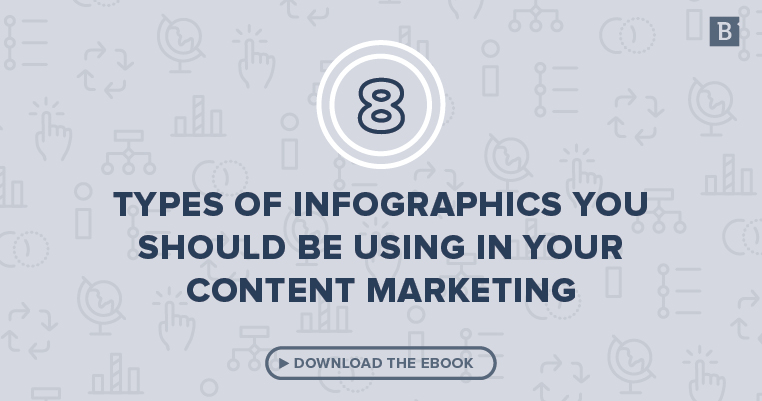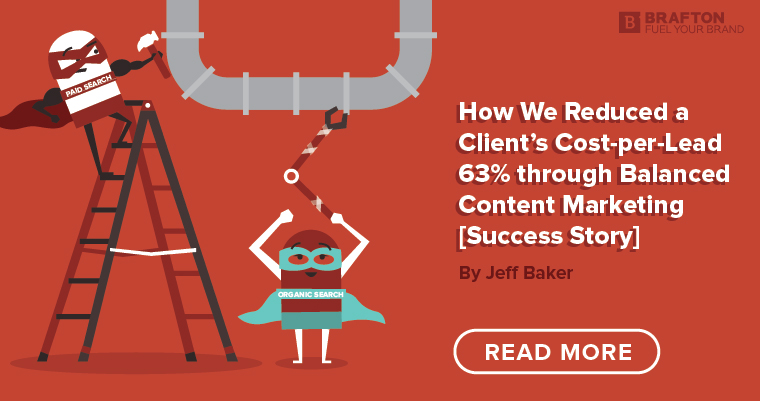There are more main characters in inbound marketing than the average movie or novel could handle, but we marketers are the talented jugglers who give numerous types of content marketing a chance to shine.
It takes skill to build a content marketing strategy that includes varied content creation and distribution, namely because each piece has to have a convincing purpose. Beyond that, variety is the spice of life, and having different kinds of content keeps your target market intrigued and engaged. And, more than that, your differing content still needs to be synchronized. It’s no good having totally disparate content that has no connecting thread, as that’ll effectively destroy all the hard work you’ve put into creating a cohesive brand identity.
It’s about creating a delicate balance of content that speaks to audiences without overwhelming them, yet still giving them reasons to come back for more. To add another layer of complexity, you need to do the homework to understand your consumers or clients: What do they need? What content will appeal to them, and convince them to convert? There are so many factors to juggle so, yeah, you could say a content marketer is pretty good at tightrope, too.
If there was a golden formula for content marketing, we would need to take the possibility of robots taking over our jobs a little more seriously. Luckily, the most effective types of content marketing vary by where they land in the marketing funnel, who they’re intended to reach, campaign goals, brand voice and so much more. In a quick little nutshell, marketing content types range from blog posts and website landing pages to promotional videos and pithy yet informative social media posts. The options are practically endless.
Still, we attempted to create a comprehensive list of each content type in action today. For our purposes, we broke them into written and visual types, but keep in mind that the two work together in nearly every piece of content you create. You can’t have a video without the script – and your script goes nowhere without recording it.
OK – now that you know what you’re getting into, we’ve got a long (yet thrilling!) list to cover.
Written content
Visual content
- Infographics
- eBook Design
- Illustrations
- Video
- Site Visuals
- Clickable CTAs
- Presentations
- Social Media Visuals
Audio Content
The Written Types of Content Marketing
Stringing together words in an intelligent manner is only one part of content writing. Those words have to speak to buyer personas, include high-performing keywords and support campaign goals. The most effective written content is relevant, measurable and impactful in helping your brand achieve desired results.
Blogs
I’ve been known to call blog posts the OG content marketing assets that continue to fill the hearts and souls of strategies near and far, and I’m sticking to my guns on that sentiment. Blog content is a staple at the top of the marketing funnel, building brand awareness and driving traffic when it lands in consumers’ search results.
While blogs can assist the sales-enablement process, their main purpose is to lead users to the next step. Ideally, readers who like what they see will explore other pages and sign up for your email newsletter so you can start a meaningful conversation with your newest qualified leads.
As with all content marketing, you always want to write with your buyer personas and campaign goals in mind. These two factors are paramount in deciding what kind of blog posts you want to create. You have several options, including:
- Evergreen articles: How-tos, long-form guides, roundups, lists and top tips all fall under this category because the information remains relevant for long periods of time. Your audience will find these articles valuable when they answer questions or offer solutions to their pain points.
- Thought leadership: You’d probably trust most things Neil Patel says about digital marketing, right? That’s because he’s a thought leader in the marketing industry. You’ll want to write accurately and consistently about industry-related trends, processes and concepts to emit the same air of authority on your own blog.
- News-based: Company news and announcements give viewers a transparent look into your brand, while discussing industry news and recent research results can also boost your relevance.
- Guest blogs: Hand the mic over to other qualified voices, asking them to contribute to your blog with a post of their own. Doing so exposes your blog to their loyal audiences and leverages expertise that your internal writers may not have.
Remember to tailor blog topics and lengths based on your audience (this goes for B2C and B2B content marketing) and content goals, sharing a healthy mix of posts to keep your viewers interested.
Success Stories
Case studies and testimonials provide potential consumers with the proof that you can follow through on your promises. With goals of lead generation and sales enablement, these success stories speak to those who are further down the funnel and are likely weighing your company against others to make a final decision.
Success stories lend themselves to hard data and results introduced by context about the company and the problems your team was able to address. Lots of direct quotes can help shape your narrative and add punches of credibility from an external voice. If possible, record interviews for testimonials. They make for engaging videos that are easily shared on social media and posted on your site.
Example: Brafton increases organic traffic by 22% YOY for Career Profiles
eBook Copy
eBooks are gated content, which means viewers have to be interested enough to complete a form fill to access the content. As such, the goal is to convert those users by revealing some impressive – but more importantly, useful – content.
Less is always more when it comes to writing eBook copy. Each page should be around 125 words to allow ample space for design elements. Make every word count, using bullet points and statistics to complement the eBook format.
More info and examples: How to create a marketing ebook
White Papers
This long-form content is similar to an eBook in that it’s gated and generates leads, but it offers an entirely different experience for your readers. A white paper is like an essay in that it dives deep into a focused topic, using authoritative language and relevant data to present an expert point of view.
While they should be professionally formatted, the majority of your efforts should go into research and writing. People who download white papers are looking for the cold hard facts and perspectives they can’t find elsewhere.
Example: Transform From Product-Centric Campaigning to Customer-Centric Experiences
Site Copy
It’s 2023, people. Every brand with any chance of success has a website. Optimized site copy is a must-have not only for favorable search rankings but also to keep viewers on your site once they get there. Engage viewers with your distinctive brand voice and interactive content like videos and graphics.
The goal will depend on the landing page, but it’s generally safe to say that site copy is meant to build awareness and ultimately convert users.
CTA Copy
There’s no beating around the bush with this copy. Calls to action give users a clear nudge toward their next step, usually in the form of hyperlinked text or clickable graphics. However, feel free to get creative with the copy and test different versions until you find the one that generates the most clicks.
Tie your CTA copy into the blog post, landing page, email, social post or other content so it’s clear without hitting readers entirely out of the blue. For instance, a blog article about kitchen remodel ideas on a home warranty provider’s blog might segue into CTA copy like:
Protect your hard work from system wear and tear with a home warranty. Check out our plans to see how they can help cover the costs of repairs and replacements.
Short-and-sweet examples:
- Let’s get to work.
- Let’s create.
- Get started.
- Click to download.
Social Media Copy
From TikTok to Twitter, social media marketing is a fundamental channel you need to utilize, but it can be tricky to get it right.
The key to posting like a pro on social media is tweaking your tone to match the social media platform. For instance, LinkedIn calls for a more professional voice in your social media content than Instagram or Twitter, which gives you more room to use casual lingo and humor. Even if you’re posting the same content on multiple platforms, tweaking the social media post’s copy and hashtag use will do a lot for engagement.
Nailing the copy is key to getting the social shares and engagement levels that earn your brand a repeat spot in user feeds.
Scripts
Without the right prep, your videos, animations and webinars will be in danger of flopping. The script creates a narrative and protects presenters and voiceovers from awkward pauses and off-topic rambling.
Script copy is always on the shorter side, written with the ultimate result in mind. Social videos, for instance, are designed for engagement and awareness. Explainer videos and testimonials target those who are higher up in the funnel, typically in the interest or consideration phase.
A general rule of thumb for any video: Save the SAT vocabulary for your white papers, because script copy should be clear and simple.
Email Copy
Email marketing is an essential way to distribute content to your audience, namely because the recipients are already interested enough in your brand to share their email. However, inundated inboxes are commonplace, which means email copy has to work doubly hard to convert audiences.
Emails generally have three main sections of copy: subject line, body copy and CTA. You can embed videos and graphics to enhance the message, but the copy is generally the narrative leader.
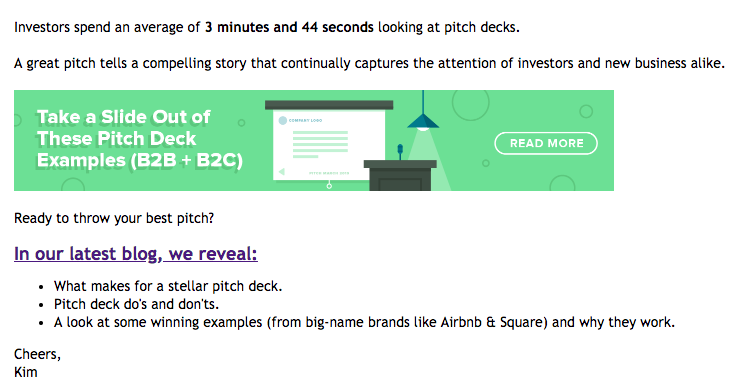
Branding Copy
Save some room in your content strategy to promote your brand’s story. We’re talking employee highlights, spotlights of your company culture at work and articles about your latest volunteer efforts.
The goal is to enhance your brand awareness with a lighter touch, providing a window into your company’s human side. As an added bonus, this kind of content can increase industry recognition and encourage potential employees to apply for open positions.
Example: We have fun writing spotlights of our talented employees in our Life At Brafton series.
Paid Ad Copy
While your strategy will likely be high in organic content, paid search and social ads still rank among the most effective content marketing tools.
Paid search helps you achieve the coveted top spot on SERPs, especially because you can pinpoint keywords that you’re struggling to make any headway on organically. Paid social ads enhance your targeting efforts, increasing the chances your brand ends up in the right feeds.
The idea is to write targeted, keyword-driven ad copy with a CTA that takes users to a highly relevant landing page – with the ultimate goal of gaining conversions, of course.

Surveys
Conducting original research through surveys and questionnaires helps you gain real insight into what your audience thinks and believes. More than customer satisfaction surveys, we’re talking about asking the industry-related questions that you and everyone else are wondering about.
Send surveys out via email and social media, leaning on your current audience for participation. When they’re truly curious about the results, those users might even encourage their own colleagues and peers to take the survey, too.
You can turn the results into blogs, social posts and graphics, sharing valuable insights that are entirely your own. People love to be in on exclusive info, which means high levels of engagement are likely. Plus, original research can elevate your brand to thought leader status.
Example: Survey: Mastering Content Marketing Management in 2023: Survey Results
User-generated Content Curation
Take a break from content creation and hand the reins over to your followers. Create social polls, start a hashtag campaign, encourage users to comment on posts, reach out to industry experts to create guest content or host a forum.
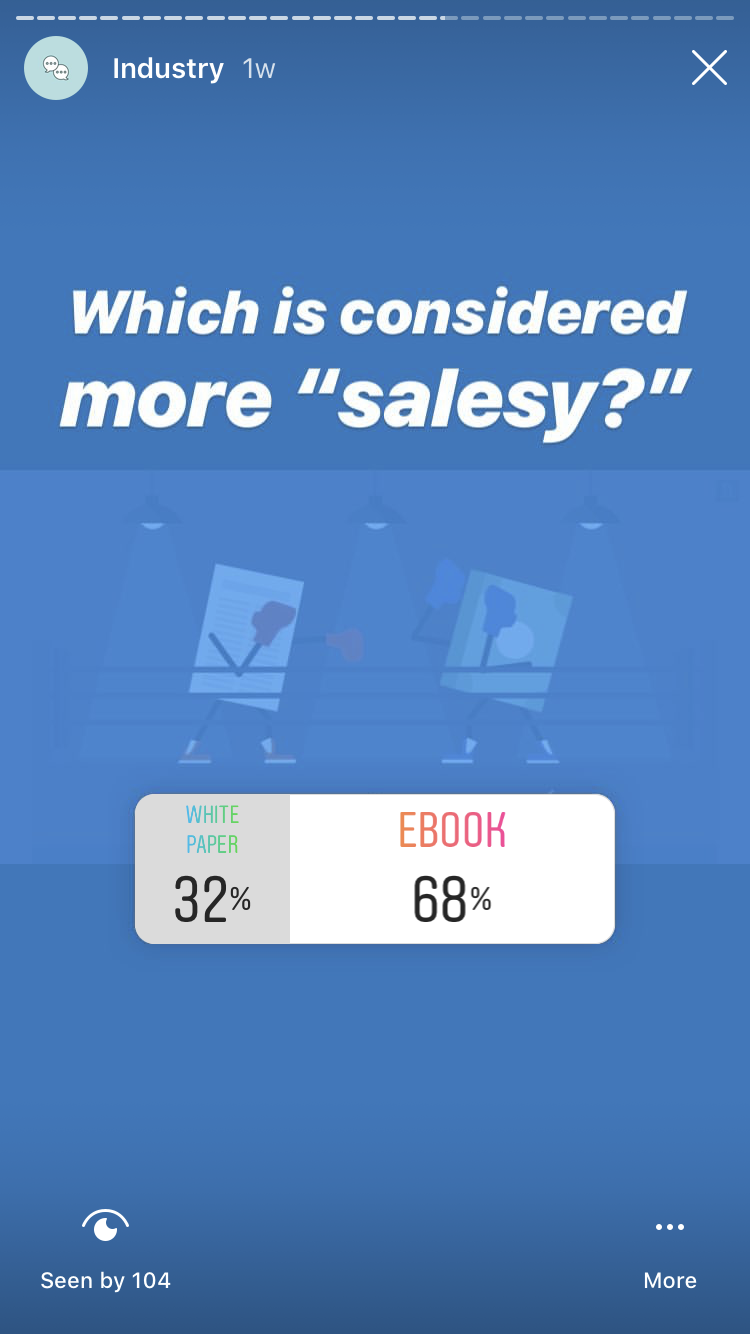
Encouraging user-generated content creates a compelling conversation with your audience. Just remember to respond to comments and reviews so users don’t feel like they’re talking into a void. If you share user content on your feeds, be sure to give credit where it’s due.
You can also repurpose user-generated content into original content, such as graphics representing poll results or blog posts that reference the content.
Re-optimization
Don’t settle for a page-five ranking when you can get to page one with a little extra polish. Dig into the analytics to see which landing pages and blog posts are showing promising performance. Give them a push by refreshing them with updated keywords, links and information. Search engine optimization — including local SEO — is critical to getting your brand in front of potential customers.
Publish the re-optimized content and watch your brand’s keyword ranking and search presence rise.
Proof it works: How re-optimizing content drove 219% more traffic [success story]
Press Releases
Sure, you can throw as many paid ads, eBooks, white papers and social media posts at your target audience as you like. But, your more engaged consumers may want some in-depth knowledge about what’s happening at your brand.
This is where press releases come in. Use them to your advantage by marketing new product or service offerings, clients or partners, events or achievements. Press releases are an effective way of keeping your target audience interested in your brand beyond seeing content promoting what they might already know.
The Visual Types of Content Marketing
Visual content helps your audience pick up what you’re laying down. Our short attention spans love the way visuals communicate messages and important takeaways in a matter of seconds. Plus, creating a recognizable aesthetic enhances your brand storytelling in the same way your tone of voice does.
Infographics
These visual representations of data are the ideal way to present statistics and complex concepts in an engaging, easily digestible manner. Even better, they can work at pretty much any stage of the buyer’s journey depending on the topic and distribution method.
You can treat these graphics like images, but know that the copy helps tell a complete story. Designers can illustrate the copy through elements like:
- Instructional diagrams.
- Flowcharts.
- Character images.
- Hand-drawn illustrations.
- Lists.
- Charts.
- Graphs.
- Maps.
- Timelines.
- Quotations.
- Statistical insights.
When the copy and design complement each other effectively, infographics can deliver a clear message that’s easily shared on your blog or social accounts.
Example of the finished result:

eBook Design
eBooks are inherently visual pieces of content, which means the design requires as much care and attention as the copy. When written well, your design elements will have room to breathe with ample whitespace.
Keep the design style consistent throughout to present a professional, easy-to-follow eBook that users are happy they downloaded.
Example: How to create sales collateral that will boost buyer confidence.
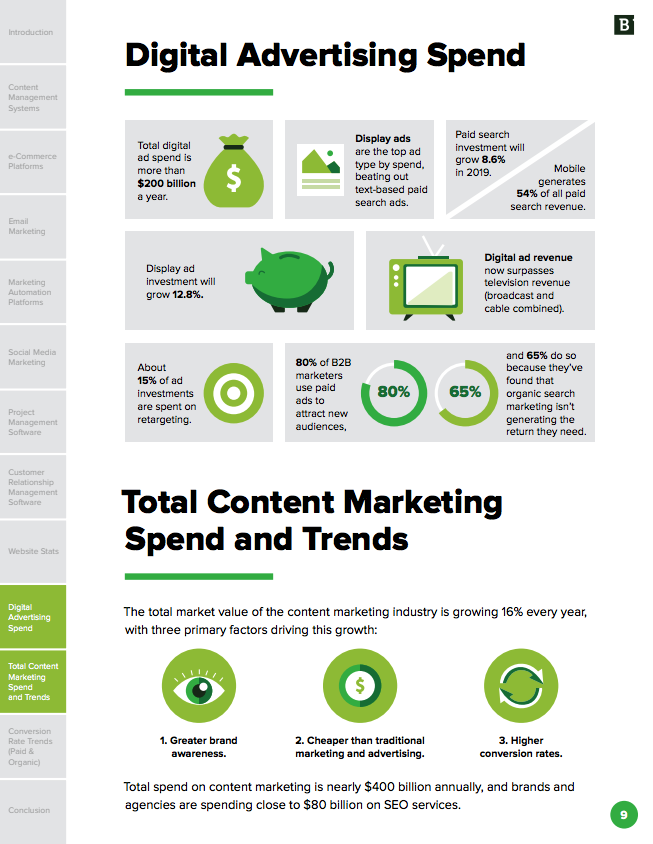
Illustrations
Custom imagery is the perfect addition to your blogs and social posts, especially when stock photos don’t quite serve your purposes. Plus, you can create a distinctive illustration style that reflects your brand voice and personality, giving your content a consistent and recognizable presence across all platforms. Hello, brand awareness!
Whether you create characters, illustrate quotes or use icons, designing your own illustration gives your content a truly personal touch.
Example: The featured image of this post! We’re big fans of custom illustrations here on the Brafton blog.

Video
Marketers who use video content grow revenue nearly 50% faster than those who don’t. With odds that high, you’re missing out on too many opportunities if you’re not utilizing video marketing in your content marketing strategy. Depending on the type and topic, videos can do a lot for your brand, including:
- Increase brand awareness.
- Improve organic ranking.
- Boost social engagement.
- Enhance lead generation efforts.
- Build brand trust and loyalty.
Before you cut to filming, there are several types of videos you can create, such as:
- Brand videos: Share your spiel, presenting a high-level overview of your brand story, vision, mission and solutions. These work well on home pages and as feature videos on your brand’s YouTube page.
- Demo videos: Show viewers how your products or services work. It could be an unboxing, a tour of your software or an inside look at your product in action.
- Event coverage: Record your live events to create a highlight reel with interviews and insights. This is especially engaging for those who weren’t in attendance.
- Explainer videos: Use these educational, how-to videos to teach your audience something new. They work especially well when embedded into a blog post that discusses the same topic!
- Interviews: Give your audience a front row seat to interviews with industry experts, internal executives and employees, and clients.
- Video blogs: These are essentially blogs in video form, making the content short and easily consumable.
Side note: Any of these videos can be either animations or live-action footage, depending on your resources and brand style.
Example:
Site Visuals
Your website content needs some striking visuals to complement your copy. Think photography, videos, icons and illustrations. If you have the resources, taking photos and videos of your office space and employees will feel way more authentic.
While there can be room for all of these visual elements on your site, don’t overload each page with too many contrasting visuals. Doing so can slow down loading times and overwhelm users, encouraging them to leave your site for a better one – effective immediately. You want to create the best experience possible for users so that they stick around to learn more about your brand.

Clickable CTAs
Elevate your CTA copy into a clickable graphic that’s easily embedded on landing pages and in emails. Try to create a template for your CTA buttons so that the style remains consistent across all content.
Here’s a classic Brafton CTA:
Presentations
New business pitches, sales demos, webinars, conferences and client meetings often flow much better when you have a slide deck prepared as a visual aid. Create templates using design tools like Adobe, Google Slides, PowerPoint and Slidebean so you can easily repurpose them for various meetings, making slight changes rather than starting from scratch each time.
Save your presentations as PDF documents or upload them to LinkedIn SlideShare so you can easily share them via email or embed them into blog posts.
Social Media Visuals
Visual content significantly boosts social engagement time and time again, making it an important aspect of your social strategy.
You can share virtually any visual on social media as long as you make sure the size, format and quality meet the platform’s requirements. Like social copy, you’ll also want to think about the type of visuals typically shared on each platform. For instance, we all know Instagram is for your flashiest photography and fun illustrations, while Facebook and LinkedIn are generally places to share article links with their accompanying feature images.
Cases in point:
Bonus Form of Content Marketing: Audio
There’s one last effective way to reach your audience and it’s through their headphones and smart speakers.
Podcasts
There’s a good chance that people who fit your target audience are among the growing number of podcast listeners. Odds are you can also think of a few energetic employees who would be willing to host a company podcast.
The platform is a great way to share opinions and lead thought-provoking conversations, plus it’s a prime opportunity to invite influencers and other industry experts to make guest appearances. You’ll want to talk about topics that are within your brand’s expertise or purpose, keeping in mind that they should also pique the interest of your target audience.
Whether you’re targeting a B2C or B2B audience, anyone can listen to your podcast when they’re driving, cooking, cleaning or working out – all of which are activities during which they’re unlikely to interact with your written and visual content.
Example: Shameless plug for Brafton’s very own Above the Fold. There are three ways to listen: iTunes, Spotify and Anchor.fm.

Create, Distribute, Repeat
If you made it this far, congratulations are in order. With each content marketing type fresh in your mind, it’s time to create valuable content that drives results. Good luck on your journey to making great content!
Editor’s Note: Updated April 2023.




